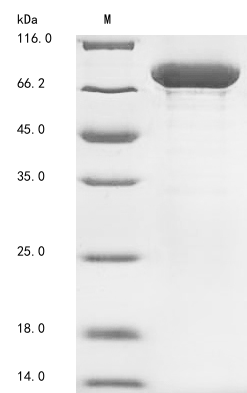The recombinant Human HSPA8 was expressed with the amino acid range of 2-646. This HSPA8 protein is theoretically predicted to have a molecular weight of 72.3 kDa. Expression of this HSPA8 protein is conducted in yeast. The HSPA8 gene fragment has been modified by fusing the N-terminal 6xHis tag, providing convenience in detecting and purifying the recombinant HSPA8 protein during the following stages.
The human heat shock cognate 71 kDa protein (HSPA8) is a member of the HSP70 family that plays a crucial role in cellular homeostasis, protein folding, and stress response. HSPA8 is involved in the ATP-dependent binding and release of unfolded or misfolded proteins, facilitating their correct folding or targeting them for degradation. It is essential for maintaining cellular proteostasis and preventing the aggregation of misfolded proteins. In addition to its role in protein quality control, HSPA8 is implicated in various cellular processes, including intracellular trafficking, endocytosis, and antigen presentation. It is induced in response to cellular stress, such as heat shock, and contributes to the cell's ability to cope with proteotoxic stress. Research on HSPA8 spans various fields, including neurodegenerative diseases, cancer, and infectious diseases.






